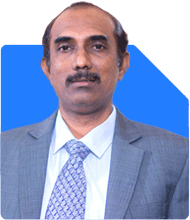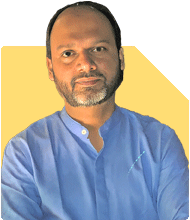Ramalingam Kalirajan |10881 Answers |Ask -Follow
Mutual Funds, Financial Planning Expert - Answered on May 20, 2024
He has an MBA in finance from the University of Madras and is a certified financial planner.
He is the director and chief financial planner at Holistic Investment, a Chennai-based firm that offers financial planning and wealth management advice.... more

Hi Sir, I'm 42 years old targeting 5 Cr in 10 years. I'm investing as 75K annual in LiC jeevan saral from last 15 years, 15k in parag Parikh flexi cap from 2 years, 10k in Sbi small cap, 5k each in NIPPON small, mid and large cap, 5k in quant infrastructure.
Current Portfolio Overview
Your current investments demonstrate a commendable commitment to securing your financial future. Investing 75K annually in LIC Jeevan Saral for 15 years shows your discipline. Additionally, your SIPs in various mutual funds highlight your diversified approach.
Evaluating Your Current Investments
LIC Jeevan Saral:
Traditional insurance plans offer moderate returns with insurance benefits.
Consider whether the returns meet your aggressive 10-year goal.
Insurance-cum-investment schemes
Insurance-cum-investment schemes (ULIPs, endowment plans) offer a one-stop solution for insurance and investment needs. However, they might not be the best choice for pure investment due to:
• Lower Potential Returns: Guaranteed returns are usually lower than what MFs can offer through market exposure.
• Higher Costs: Multiple fees in insurance plans (allocation charges, admin fees) can reduce returns compared to the expense ratio of MFs.
• Limited Flexibility: Lock-in periods restrict access to your money, whereas MFs provide more flexibility.
MFs, on the other hand, focus solely on investment and offer:
• Potentially Higher Returns: Investments in stocks and bonds can lead to higher growth compared to guaranteed returns.
• Lower Costs: Expense ratios in MFs are generally lower than the multiple fees in insurance plans.
• Greater Control: You have a wider range of investment options and control over asset allocation to suit your risk appetite.
Consider your goals!
• Need life insurance? Term Insurance plans might be suitable.
• Focus on growing wealth? MFs might be a better option due to their flexibility and return potential.
Equity Mutual Funds:
Your choices include diversified equity funds and sector-specific funds.
Equity funds generally provide higher returns over the long term.
Strategic Adjustments for Better Returns
To achieve your 5 crore target in 10 years, consider the following adjustments and strategies:
Increase Equity Exposure:
Equities tend to outperform other asset classes over the long term.
Consider increasing your SIP amounts in high-performing equity funds.
Diversify Across Fund Categories:
Continue with diversified funds but also consider balanced advantage funds.
Balanced funds offer a mix of equity and debt, reducing risk while aiming for growth.
Review Sectoral Funds:
Sector-specific funds can be volatile. Regularly review their performance.
Consider shifting to more stable, diversified funds if needed.
Additional Investment Strategies
Systematic Transfer Plan (STP):
If you have a lump sum amount, use STP to invest gradually into equity funds.
This strategy can help mitigate market volatility.
Top-up SIP:
Increase your SIP contributions annually by at least 10-15%.
This helps in compounding your returns significantly over time.
Focus on High-Performing Funds:
Regularly review your mutual fund portfolio.
Shift investments from underperforming funds to those with consistent track records.
Risk Management and Contingency Planning
Emergency Fund:
Ensure you have an emergency fund equivalent to 6-12 months of expenses.
This safeguards against unforeseen financial needs.
Adequate Insurance Coverage:
Maintain sufficient health and life insurance coverage.
This protects your investments and family’s financial security.
Tax Planning:
Utilize tax-efficient investment avenues.
Consider Equity-Linked Savings Schemes (ELSS) for tax benefits under Section 80C.
Monitoring and Reviewing Your Portfolio
Regular Portfolio Review:
Review your portfolio performance at least semi-annually.
Make adjustments based on market conditions and personal financial goals.
Consultation with a Certified Financial Planner:
Seek advice from a CFP to ensure your investments align with your goals.
A professional can provide tailored advice and timely adjustments.
Conclusion
Achieving a target of 5 crores in 10 years requires disciplined investing and strategic adjustments. By increasing your equity exposure, diversifying your investments, and regularly reviewing your portfolio, you can enhance your chances of meeting this ambitious goal. Remember, consistent and informed investing, coupled with prudent risk management, is key to financial success.
Best Regards,
K. Ramalingam, MBA, CFP,
Chief Financial Planner,
www.holisticinvestment.in
You may like to see similar questions and answers below
Sanjeev Govila | Answer |Ask -Follow
Financial Planner - Answered on Nov 15, 2023
Ramalingam Kalirajan |10881 Answers |Ask -Follow
Mutual Funds, Financial Planning Expert - Answered on May 20, 2024
Ramalingam Kalirajan |10881 Answers |Ask -Follow
Mutual Funds, Financial Planning Expert - Answered on May 14, 2024
Ramalingam Kalirajan |10881 Answers |Ask -Follow
Mutual Funds, Financial Planning Expert - Answered on Nov 21, 2024
Ramalingam Kalirajan |10881 Answers |Ask -Follow
Mutual Funds, Financial Planning Expert - Answered on Jul 28, 2025
Nayagam P P |10854 Answers |Ask -Follow
Career Counsellor - Answered on Dec 14, 2025
Radheshyam Zanwar |6744 Answers |Ask -Follow
MHT-CET, IIT-JEE, NEET-UG Expert - Answered on Dec 14, 2025
Radheshyam Zanwar |6744 Answers |Ask -Follow
MHT-CET, IIT-JEE, NEET-UG Expert - Answered on Dec 14, 2025
Dr Dipankar Dutta |1840 Answers |Ask -Follow
Tech Careers and Skill Development Expert - Answered on Dec 14, 2025
Dr Dipankar Dutta |1840 Answers |Ask -Follow
Tech Careers and Skill Development Expert - Answered on Dec 13, 2025
Dr Dipankar Dutta |1840 Answers |Ask -Follow
Tech Careers and Skill Development Expert - Answered on Dec 13, 2025
Mayank Chandel |2575 Answers |Ask -Follow
IIT-JEE, NEET-UG, SAT, CLAT, CA, CS Exam Expert - Answered on Dec 13, 2025
Radheshyam Zanwar |6744 Answers |Ask -Follow
MHT-CET, IIT-JEE, NEET-UG Expert - Answered on Dec 13, 2025
Mayank Chandel |2575 Answers |Ask -Follow
IIT-JEE, NEET-UG, SAT, CLAT, CA, CS Exam Expert - Answered on Dec 13, 2025
Mayank Chandel |2575 Answers |Ask -Follow
IIT-JEE, NEET-UG, SAT, CLAT, CA, CS Exam Expert - Answered on Dec 13, 2025
























